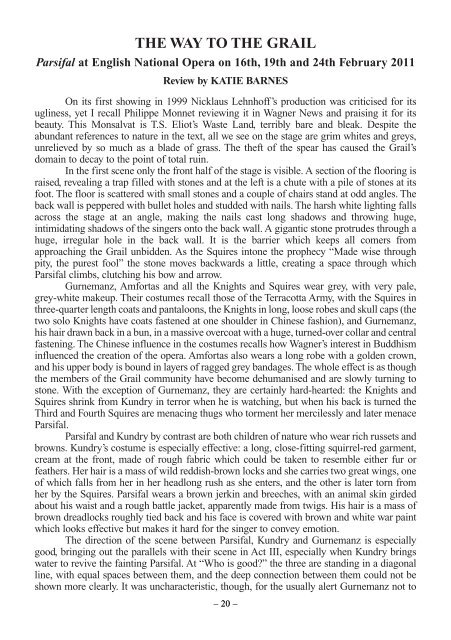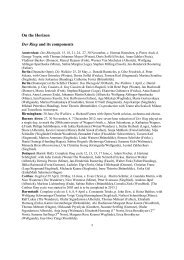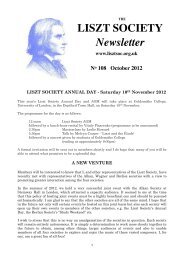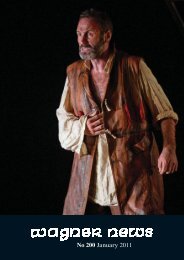Number 201: APRIL 2011 - Wagner Society of England
Number 201: APRIL 2011 - Wagner Society of England
Number 201: APRIL 2011 - Wagner Society of England
Create successful ePaper yourself
Turn your PDF publications into a flip-book with our unique Google optimized e-Paper software.
THE WAY TO THE GRAIL<br />
Parsifal at English National Opera on 16th, 19th and 24th February <strong>201</strong>1<br />
Review by KATIE BARNES<br />
On its first showing in 1999 Nicklaus Lehnh<strong>of</strong>f’s production was criticised for its<br />
ugliness, yet I recall Philippe Monnet reviewing it in <strong>Wagner</strong> News and praising it for its<br />
beauty. This Monsalvat is T.S. Eliot’s Waste Land, terribly bare and bleak. Despite the<br />
abundant references to nature in the text, all we see on the stage are grim whites and greys,<br />
unrelieved by so much as a blade <strong>of</strong> grass. The theft <strong>of</strong> the spear has caused the Grail’s<br />
domain to decay to the point <strong>of</strong> total ruin.<br />
In the first scene only the front half <strong>of</strong> the stage is visible. A section <strong>of</strong> the flooring is<br />
raised, revealing a trap filled with stones and at the left is a chute with a pile <strong>of</strong> stones at its<br />
foot. The floor is scattered with small stones and a couple <strong>of</strong> chairs stand at odd angles. The<br />
back wall is peppered with bullet holes and studded with nails. The harsh white lighting falls<br />
across the stage at an angle, making the nails cast long shadows and throwing huge,<br />
intimidating shadows <strong>of</strong> the singers onto the back wall. A gigantic stone protrudes through a<br />
huge, irregular hole in the back wall. It is the barrier which keeps all comers from<br />
approaching the Grail unbidden. As the Squires intone the prophecy “Made wise through<br />
pity, the purest fool” the stone moves backwards a little, creating a space through which<br />
Parsifal climbs, clutching his bow and arrow.<br />
Gurnemanz, Amfortas and all the Knights and Squires wear grey, with very pale,<br />
grey-white makeup. Their costumes recall those <strong>of</strong> the Terracotta Army, with the Squires in<br />
three-quarter length coats and pantaloons, the Knights in long, loose robes and skull caps (the<br />
two solo Knights have coats fastened at one shoulder in Chinese fashion), and Gurnemanz,<br />
his hair drawn back in a bun, in a massive overcoat with a huge, turned-over collar and central<br />
fastening. The Chinese influence in the costumes recalls how <strong>Wagner</strong>’s interest in Buddhism<br />
influenced the creation <strong>of</strong> the opera. Amfortas also wears a long robe with a golden crown,<br />
and his upper body is bound in layers <strong>of</strong> ragged grey bandages. The whole effect is as though<br />
the members <strong>of</strong> the Grail community have become dehumanised and are slowly turning to<br />
stone. With the exception <strong>of</strong> Gurnemanz, they are certainly hard-hearted: the Knights and<br />
Squires shrink from Kundry in terror when he is watching, but when his back is turned the<br />
Third and Fourth Squires are menacing thugs who torment her mercilessly and later menace<br />
Parsifal.<br />
Parsifal and Kundry by contrast are both children <strong>of</strong> nature who wear rich russets and<br />
browns. Kundry’s costume is especially effective: a long, close-fitting squirrel-red garment,<br />
cream at the front, made <strong>of</strong> rough fabric which could be taken to resemble either fur or<br />
feathers. Her hair is a mass <strong>of</strong> wild reddish-brown locks and she carries two great wings, one<br />
<strong>of</strong> which falls from her in her headlong rush as she enters, and the other is later torn from<br />
her by the Squires. Parsifal wears a brown jerkin and breeches, with an animal skin girded<br />
about his waist and a rough battle jacket, apparently made from twigs. His hair is a mass <strong>of</strong><br />
brown dreadlocks roughly tied back and his face is covered with brown and white war paint<br />
which looks effective but makes it hard for the singer to convey emotion.<br />
The direction <strong>of</strong> the scene between Parsifal, Kundry and Gurnemanz is especially<br />
good, bringing out the parallels with their scene in Act III, especially when Kundry brings<br />
water to revive the fainting Parsifal. At “Who is good?” the three are standing in a diagonal<br />
line, with equal spaces between them, and the deep connection between them could not be<br />
shown more clearly. It was uncharacteristic, though, for the usually alert Gurnemanz not to<br />
– 20 –










